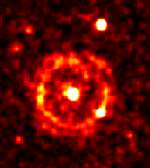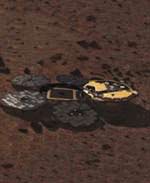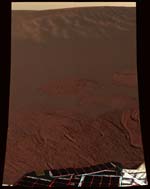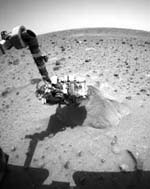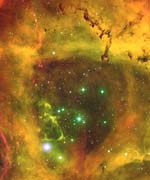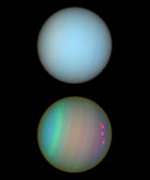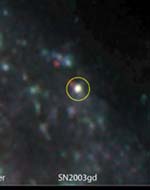
Image credit: Gemini
Like a doctor trying to understand an elderly patient’s sudden demise, astronomers have obtained the most detailed observations ever of an old but otherwise normal massive star just before and after its life ended in a spectacular supernova explosion.
Imaged by the Gemini Observatory and Hubble Space Telescope (HST) less than a year prior to the gigantic explosion, the star is located in the nearby galaxy M-74 in the constellation of Pisces. These observations allowed a team of European astronomers led by Dr. Stephen Smartt of the University of Cambridge, England to verify theoretical models showing how a star like this can meet such a violent fate.
The results were published in the January 23, 2004 issue of the journal Science. This work provides the first confirmation of the long-held theory that some of the most massive (yet normal) old stars in the Universe end their lives in violent supernova explosions.
“It might be argued that a certain amount of luck or serendipity was involved in this finding,” said Dr. Smartt. “However, we’ve been searching for this sort of normal progenitor star on its deathbed for some time. I like to think that finding the superb Gemini and HST data for this star is a vindication of our prediction that one day we had to find one of these stars in the immense data archives that now exist.” Click here for more details on Dr. Smartt’s ongoing supernova program.
During the last few years, Smartt’s research team has been using the most powerful telescopes, both in space and on the ground, to image hundreds of galaxies in the hope that one of the millions of stars in these galaxies will some day explode as a supernova. In this case, the renowned Australian amateur supernova hunter, Reverend Robert Evans, made the initial discovery of the explosion (identified as SN203gd) while scanning galaxies with a 12-inch (31cm) backyard telescope from his home in New South Wales, Australia in June, 2003.
Following Evans’ discovery, Dr. Smartt’s team quickly followed up with detailed observations using the Hubble Space Telescope. These observations verified the exact position of the original or “progenitor” star. Using this positional data, Smartt and his team dug through data archives and discovered that observations by the Gemini Observatory and HST contained the combination of data necessary to reveal the nature of the progenitor.
The Gemini data was obtained during the commissioning of the Gemini Multi-Object Spectrograph (GMOS) on Mauna Kea, Hawaii in 2001. These data were also used to produce a stunning high-resolution image of the galaxy that clearly shows the red progenitor star. Click here for the full resolution Gemini image.
Armed with the earlier Gemini and HST observations Smartt’s team was able to demonstrate that the progenitor star was what astronomers classify as a normal red supergiant. Prior to exploding, this star appeared to have a mass about 10 times greater, and a diameter about 500 times greater than that of our Sun. If our sun were the size of the progenitor it would engulf the entire inner solar system out to about the planet Mars.
Red supergiant stars are quite common in the universe and an excellent example can be easily spotted during January from almost anywhere on the Earth by looking at Betelgeuse, the bright red shoulder star in the constellation of Orion (see finder chart here.) Like SN2003gd, it is believed that Betelgeuse could meet the same explosive fate at any time from next week to thousands of years from now.
After SN2003gd exploded, the team observed its gradually fading light for several months using the Isaac Newton Group of telescopes on La Palma. These observations demonstrated that this was a normal type II supernova, which means that the ejected material from the explosion is rich in hydrogen. Computer models developed by astronomers have long predicted that red supergiants with extended, thick atmospheres of hydrogen would produce these type II supernovae but until now have not had the observational evidence to back up their theories. However, the fantastic resolution and depth of the Gemini and Hubble images allowed the Smartt team to estimate the temperature, luminosity, radius and mass of this progenitor star and reveal that it was a normal large, old star. “The bottom-line is that these observations provide a strong confirmation that the theories for both stellar evolution and the origins of these cosmic explosions are correct,” said co-author Seppo Mattila of Stockholm Observatory.
This is only the third time astronomers have actually seen the progenitor of a confirmed supernova explosion. The others were peculiar type II supernovae: SN 1987A, which had a blue supergiant progenitor, and SN 1993J, which emerged from a massive interacting binary star system. Click here for more details.
Dr. Smartt concludes, “Supernova explosions produce and distribute the chemical elements that make up everything in the visible Universe ? especially life. It is critical that we know what type of stars produce these building blocks if we are to understand our origins.”
Archived Gemini and HST data was critical to the success of this project. “This discovery is a perfect example of archival data’s immense value to new scientific projects,” said Dr. Colin Aspin who is the Gemini Scientist responsible for the development of the Gemini Science Archive (GSA). He continued, “this discovery demonstrates the spectacular results that can be realized by using archival data and stresses the importance of developing the GSA for future generations of astronomers.”
The Gemini Multi-Object Spectrograph used to make the Gemini observations are twin instruments built as a joint partnership between Gemini, the Dominion Astrophysical Observatory, Canada, the UK Astronomy Technology Centre and Durham University, UK. Separately, the U.S. National Optical Astronomy Observatory provided the detector subsystem and related software. GMOS is primarily designed for spectroscopic studies where several hundred simultaneous spectra are required, such as when observing star and galaxy clusters. GMOS also has the ability to focus astronomical images on its array of over 28 million pixels.
The Isaac Newton Group of Telescopes (ING) is an establishment of the Particle Physics and Astronomy Research Council (PPARC) of the United Kingdom, the Nederlandse Organisatie voor Wetenschappelijk Onderzoek (NWO) of the Netherlands and the Instituto de Astrof?sica de Canarias (IAC) in Spain. The ING operates the 4.2 metre William Herschel Telescope, the 2.5 metre Isaac Newton Telescope, and the 1.0 metre Jacobus Kapteyn Telescope. The telescopes are located in the Spanish Roque de Los Muchachos Observatory on La Palma which is operated by the Instituto de Astrof?sica de Canarias (IAC).
Background Information:
Supernovae are among the most energetic phenomena observed in the entire Universe. When a star of more than about eight times the mass of our Sun reaches the end of its nuclear fuel reserve, its core is no longer stable from collapsing under its own immense weight. As the core of the star collapses, the outer layers are ejected in a fast-moving shock wave. This huge energy release results in a supernova that is about one billion times brighter than our Sun, and is comparable to the brightness of an entire galaxy. After destroying itself, the core of the star becomes either a neutron star or a black hole.
The team is composed of Stephen J. Smartt, Justyn R. Maund, Margaret A. Hendry, Christopher A. Tout, and Gerald F. Gilmore (University of Cambridge, UK), Seppo Mattila (Stockholm Observatory, Sweden), and Chris R. Benn (Isaac Newton Group of Telescopes, Spain).
Original Source: Gemini News Release

